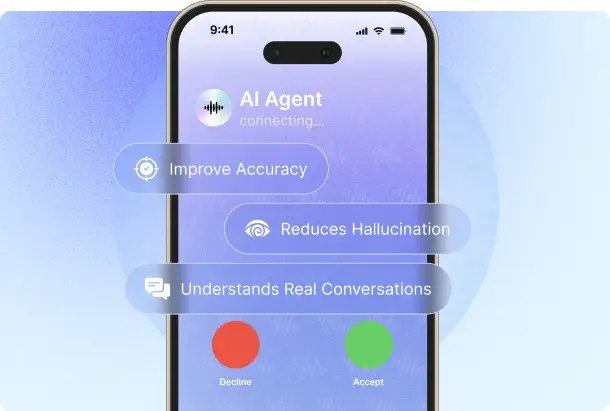What Are RAG AI Voice Agents?
Retrieval-Augmented Generation (RAG) enhances traditional language models by integrating a retrieval step that fetches relevant, real-time data to ground AI outputs in factual knowledge. This fusion improves accuracy, reduces hallucinations, and ensures more reliable AI-generated responses. Discover how we leverage RAG to deliver next-gen, intelligent voice experiences.

Key Steps in Integrating External Data
Integration of external data is a four-pronged approach that involves the following steps.
User Query Processing
When a user query arrives, RAG agents parse it and decide whether to fetch additional context. Queries that demand up-to-date information will trigger a retrieval workflow.
Retrieval Component
The RAG system performs a semantic query across external sources, retrieving relevant data and recent documents. This retrieved data (articles, database entries) is then distilled into relevant context: bullet points or short passages that directly answer sub-questions embedded in the original request.
Generative Layer
The generative model (the language model) receives the user query along with the retrieved context. By combining its pre-trained knowledge with fresh inputs, it ensures accurate information is woven into the final response.
Response Generation and Validation
After generating a draft, RAG agents apply an internal validation step, they double-check key facts against the retrieved context. This agent observes and confirms consistency or flags potential inconsistencies, further reducing the risk of hallucinations.
Use Cases That Drive Agentic RAG Development

Context-Aware Generation
In customer service, agents must adapt to previous interactions (previous interactions) and maintain conversational state. Agentic RAG structures allow context tracking so follow-up queries are answered accurately.

Real-Time Actions
Agents can integrate with external tools (CRM platforms, task schedulers, ticketing systems) to “book meetings,” “create support tickets,” or “trigger alerts.” This combination of retrieval and actioning transforms RAG AI agents from mere answer engines into full-fledged autonomous systems.
Benefits of RAG AI Agents in Communication
Here are the reasons why RAG AI agents are the new communication tools for enterprises.

Grounding Responses & Reducing Hallucinations
Traditional large language models might confidently generate false statements. RAG AI agents mitigate this by grounding responses in fetched facts.

Precise, Timely Information
Whether the user query concerns “today’s exchange rates,” “news headlines from the past hour,” or “latest medical guidelines,” RAG AI agents can tap into external sources and data sources to furnish answers that reflect the current moment.

Scalability via Multi-Agent Collaboration
Agentic RAG systems distribute labor across a network of specialized agents—retrieval, validation, and generation—each operating in parallel. As a result, they can handle hundreds of concurrent requests while maintaining low latency.

Enhanced User Engagement
Interactive voice agents that deeply understand a user’s context can ask clarifying questions or surface additional suggestions, thus creating a more conversational, human-like experience. Because responses are both accurate and personalized, users trust these agents more and feel encouraged to ask follow-up questions.
Real-World Use Cases

News & Finance
RAG’s ability to incorporate real-time data shines in rapidly changing domains. For example, a financial voice agent can fetch the latest stock prices from a live API and instantly ground its commentary in those figures. Journalists and analysts who rely on quick market snapshots benefit from up-to-date information while reducing the risk of outdated or incorrect statements.

Healthcare & Medical Research
RAG voice agents can retrieve the latest clinical trial results or updated treatment guidelines from a hospital’s research database. By referencing external knowledge sources, like PubMed or internal EHR systems, healthcare providers get concise summaries that can inform patient care decisions. This agentic RAG pipeline fosters better patient outcomes and decreases administrative overhead.

Customer Support & E-Commerce
Voice assistants in e-commerce can quickly check product availability, shipping estimates, and customer order history. The retrieval agent fetches data from order management systems, while the generation agent packages that data into fluent, personalized replies. By avoiding hallucinations, these agents build trust and reduce support ticket volumes.

Enterprise Knowledge Management
Large organizations house vast troves of documentation, standard operating procedures (SOPs), and compliance manuals. Traditional search tools often produce overwhelming results. By applying a retrieval augmented generation component, AI voice agents surface the most relevant information, and then the language model presents concise, actionable answers. Teams spend less time wading through documents and more time executing tasks.
Frequently Asked Questions
What distinguishes Retrieval-Augmented Generation (RAG) from traditional language models?
RAG supplements a pre-trained model by pulling fresh data from external sources at inference time, whereas traditional models rely solely on existing parameters.
How do AI agents enhance RAG-based architectures?
AI agents divide responsibilities, one agent retrieves information, another validates it, and a third crafts the ultimate response, whereas monolithic systems handle all steps in a single pass.
Can RAG improve and enrich my existing knowledge base?
Absolutely, by continuously pulling in external information, RAG breathes new life into stale data repositories, whereas static knowledge bases risk becoming outdated.
How does user feedback refine RAG pipelines over time?
User response triggers a feedback loop: retrieval parameters get fine-tuned, and validation agents learn to flag weaker sources.
Is response generation consistently reliable in RAG AI Agents?
Because RAG focuses on grounding outputs in external sources before generating text, accuracy surpasses that of models without a retrieval step.